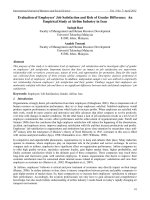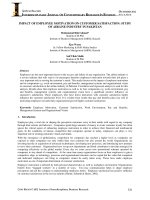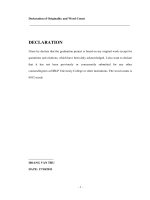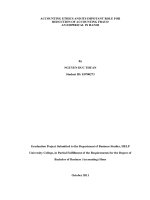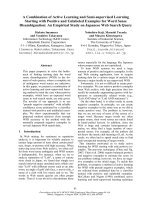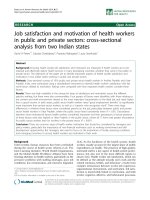Evaluation of employees’ job satisfaction and role of gender difference an empirical study at airline industry in iran
Bạn đang xem bản rút gọn của tài liệu. Xem và tải ngay bản đầy đủ của tài liệu tại đây (274.63 KB, 11 trang )
International Journal of Business and Social Science
Vol. 3 No. 7; April 2012
Evaluation of Employees’ Job Satisfaction and Role of Gender Difference: An
Empirical Study at Airline Industry in Iran
Sadegh Rast
Faculty of Management and Human Resource Development
Universiti Teknologi Malaysia
81300, Johor, Malaysia.
Azadeh Tourani
Faculty of Management and Human Resource Development
Universiti Teknologi Malaysia
81300, Johor, Malaysia.
Abstract
This purpose of this study is to determine level of employees’ job satisfaction and to investigate effect of gender
on employees’ job satisfaction. Important factors that have an impact on job satisfaction are supervision,
relationship with co-workers, present pay, nature of work, and opportunities for promotion. Data for this study
was collected from employees of three private airline companies in Iran. Descriptive analysis performed to
determine level of employees’ job satisfaction. In addition, independent-sample t-test was utilized to empirically
test relationship between employees’ job satisfaction and their gender. Findings suggest that employees are
moderately satisfied with their job and there is no significant difference between male and female employees’ job
satisfaction.
Keywords: Employees‟ Job Satisfaction, Gender, Airline, Iran
1. Introduction
Organizations strongly desire job satisfaction from their employees (Oshagbemi, 2003). Due to important role of
human resource on organization performance, they try to keep employees satisfied. Satisfied employees would
produce superior performance in optimal time which leads to increase profits. When employees are satisfied with
their work, would be more creative and innovative and offer advances that allow company to evolve positively
over time with changes in market conditions. On the other hand, a lack of job satisfaction results in a low level of
employee commitment that, in turn, affect performance and the achievement of organizational goals. Farrell and
Stamm (1988) draw the conclusion that high employee satisfaction will reduce the happening of the absenteeism,
accident, and employee stress, improve employee satisfaction with life and thus increase productivity and profits.
Employees‟ job satisfaction in organizations and institutions has given close attention by researchers since mid20th century after the emergence of Maslow‟s theory of Need Hierarchy in 1943. Literature in this area is filled
with various analytical studies (Ajayi, 1998; Chimanikire et al., 2007; Williams, 1998).
In competitive and unpredictable phenomena, organizations try to keep and enhance their place. Many industries
operate in situation, where employees play an important role in the product and service exchange. In service
company such as airlines, employees have significant effect on organization performance. Airline companies try
to offer high quality services, maximize customer loyalty, gain higher market share, higher profitability, and
finally customer satisfaction which is the ultimate goal of these companies. These companies may reach these
long-term and short-term goals with satisfied employees. It means organizations that desire to improve their
customer satisfaction must be concerned about internal issues related to employees‟ satisfaction and view their
employees as customer too (Harter et al., 2002; Wangenheim et al., 2007).
In Airlines, employees‟ behavior is critical and poor treatment of customers may directly impact on their image
(Hunter, 2006). In airline industry in Iran, there is intense competition between private and public companies to
gain higher portion of market share. So, these companies try to increase their employees‟ satisfaction to enhance
their performance. Accordingly, the aviation professionals not only have to gain advanced and comprehensive
knowledge, but also needs holistic understanding of airline industry‟s needs based on today‟s rapidly changing air
transport environment.
91
© Centre for Promoting Ideas, USA
www.ijbssnet.com
The fundamental objective of this study is to determine level of employees‟ job satisfaction among three private
airlines in Iran. Hence, the research tries to investigate effect of gender on employees‟ job satisfaction. It is
anticipated that the study would provide worthy information not only to academic community, but also to
practitioners that would facilitate them to make knowledgeable managerial decisions in Iran. Have a better
understanding of aspects of employees‟ job satisfaction is vital for service companies. This will allow companies
to design human resource management system that is able to motivate, attract, and retain their employees (Ralston
et al., 1997). In line with the objective, the rest of the paper describes definition of job satisfaction, theories
related to job satisfaction, determinants of job satisfaction, and methodology adopted. Subsequently, the main
findings are presented and discussed and finally conclusions and managerial implications of the findings and
research areas are discussed for further inquiry and understanding.
2. Definition of Job Satisfaction
The concept of job satisfaction was first developed from the Hawthorne studies of the late 1920s and early 1930s
by Elton Mayo at the Hawthorne plant of the Western Electric Company in Chicago. The result was that the
emotions of employees can influence their working behaviors. Social relationships and psychological factors are
the main causes of job satisfaction and productivity in employees (Robbins, 2002).
Based on comparison among review of literature in job satisfaction, many researchers define job satisfaction. Job
Satisfaction is “an affective and emotional response to various facets of one‟s job” (Kreitner and Kinicki 2004),
and Locke (1968) describes as “being an emotional response that results from the employee‟s perceived
fulfillment of their needs and what they believes the company to have offered”. Although recently researchers
have tried to reflect current theoretical underpinnings of job satisfaction, Robert Hoppock‟s (1935) definition
which was one of the earliest definitions of this concept is still the most cited one. He says job satisfaction is “any
combination of psychological, physiological, and environmental circumstances that causes a person truthfully to
say, „I am satisfied with my job‟ ” (Hoppock, 1935). The concept of job satisfaction and its definition have
continually grown, expanded and unfolded through the previous decades. Although basically it is a work-related
positive affective reaction in majority of the definitions, less consistency can be observed in the factors that bring
about job satisfaction. This inconsistency may be because job satisfaction can be influenced by various factors
including personal traits and characteristics of the job (Wexley and Yukl, 1984). To get deep understanding of
employees, characteristics of jobs and their relation to the issue of job satisfaction various theories have been
formulated. These theories aim at developing appropriate research frameworks for further studies on this concept.
3. Theories of job satisfaction
There are numerous theories attempt to explain job satisfaction, but two conceptual frameworks seem to be more
prominent in the literature. These frameworks are named as content theories and process theories. In the following
sections the main theories and theorists from each framework are discussed to clarify the relevance and direction
of them to the current study.
3.1. Content Theories
Based on Content theory, job satisfaction is gained when an employee feels that his job gives him the sense of
growth and self-actualization. The discussion of these two factors directly links to Maslow‟s hierarchy of needs.
Content theories assume that all employees in the organization have the same set of needs and therefore predict
the characteristics that should be present in the job. These theories emphasize on the factors and needs that
encourage and inspire the behavior as well as performance (Nel et al., 2004).
3.2. Process theories
In process theories, job satisfaction is explained by the extent to which an individual‟s expectations and values are
met in a job (Gruneberg, 1979). Based on these theories job-holders‟ behavior is driven by their needs. These
theories focus on employees‟ diverse needs and the cognitive process behind these diversities. In these theories,
sources, and causes of employees‟ behaviors, as well as the motives that affect the intensity and direction of those
behaviors are given attention. A summary of theoretical frameworks and relevant theories has been shown in
Table 1.
92
International Journal of Business and Social Science
Vol. 3 No. 7; April 2012
Table 1: Summary of Theoretical Frameworks and Relevant Theories
Category
Content
Process
Theory
Need Hierarchy Theory
Two- Factor Theory
Achievement Theory
X and Y Theory
Existence, Relatedness, and Growth
Expectancy Theory
Equity Theory
Goal Setting Theory
Authors
Maslow (1943)
Herzberg (1959)
McClelland (1958)
McGregor (1960)
Alderfer (1969)
Vrooms (1964)
Adams (1963)
Locke (1968)
4. Determinant of job satisfaction
The conceptual domain of job satisfaction is too broad, since it involves the job and its environment
characteristics. Thus, in order to manage the broadness and obtain measures of job satisfaction two approaches
have been developed: global scale and facet scale. While the former attempts to combine an employee‟s reaction
to different aspects of his job single, integrated response, the latter tries to cover each of the principal areas
separately within the general satisfaction domain. Regard to these two approaches, several researchers offer
different measurements tools for measuring job satisfaction. Smith et al. (1969) define five facets for measuring
job satisfaction. Based on their instrument, job satisfaction consists of several facets, including satisfaction with
the supervisor, relationship with coworkers, present pay, nature of work, and opportunities for promotion.
4.1. Nature of work
The nature of the work performed by employees has a significant effect on their level of job satisfaction
(Larwood, 1984; Landy, 1989; Luthans, 2006; Griffen and Moorhead, 2009). Robbins et al. (2003) refer to the
work itself as “the extent to which the job provides the individual with stimulating tasks, opportunities for
learning and personal growth, and the chance to be responsible and accountable for results”.
Sharma and Bhaskar (1991) assume that most significant influence over job satisfaction of employees appears
from the nature of the work given to them. In addition, they assert job satisfaction can be achieved by employees
if the job requires sufficient variety, discretion, challenge and scope for using an individual‟s own skills and
abilities. The study that was done on Indian managers by Khaleque and Choudhary (1984) shown that the most
essential factor to verify top managers‟ job satisfaction is the nature of work. It was also found out that the job
security is considered as the most significant factor among managers of lower rank job satisfaction. In addition,
Landy (1989) believes that job satisfaction is achieved for jobs which are found to be interesting to employees.
4.2. Present Pay
Many researchers have done studies regard to the influence of pay on job satisfaction (Luthans, 2006; Taylor and
West, 1992; Robbins, 2004). Luthans (2006) claimed that apart from helping people to achieve and obtain their
basic needs, salaries also work to satisfy the higher level needs of people. Taylor and West (1992) figured out that
job satisfaction is affected by the payment levels affect. It is reported that most public employees will feel less
satisfy with their jobs if they compare their salaries to those who work for the private sector.
Robbins et al. (2003) supposed that most employees will look for payment systems that believed to be fair,
definite, and aligned with their expectations. Satisfaction is expected to be achieved if the payment seems to be
equitable, equal with job demands, individual skill level and community payment standards. In contrast, the
findings of survey performed by Brainard (2005) figured out that job satisfaction is less likely to be connected
with the payment and benefits.
4.3. Opportunities for Promotion
Several researchers share the opinion that job satisfaction has a great connection with is opportunities for
promotion (Pergamit and Veum, 1999; Sclafane, 1999; Ellickson and Logsdon, 2002; Peterson et al., 2003).
Promotion as defined by Heery and Noon (2001) refers to “the action of shifting an employee up the organization
hierarchy which will normally bring to an increase of responsibility and status and a better remuneration package
among the individuals who are promoted”. Kreitner and Kinicki (2004) mentioned that job satisfaction and the
promotion positive relationship relies on supposed fairness by employees. A lot of people will experience
satisfaction when they think that they have good future opportunities as supposed by Drafke and Kossen (2002).
93
© Centre for Promoting Ideas, USA
www.ijbssnet.com
This can be interpreted as the opportunities for progression and development in their present workplace or
providing better chances to look out for alternative employment. It is assumed that the level of job satisfaction
will go down if people think that they have less career advancement opportunities. McCormick (2008) mentioned
that job satisfaction among employees with promotional opportunities will rely on the promotions equity.
4.4. Supervision
Many Researches reveal that supervision and job satisfaction has a positive relationship (Peterson et al., 2003;
Koustelios, 2001; Smucker et al., 2003).According to Heery and Noon (2001), a supervisor is defined as “a frontline manager who is responsible for the supervision of employees”. Nel et al. (2004) regard the supervisors as
employees who regulate the activities of lower-level employees. Staudt (1997) research has noticed that
respondents are probably to feel satisfied generally with their job if they feel satisfied with their supervisors.
Supervision outlines a very important role that has to do with employees‟ job satisfaction in terms of the
supervisor‟s capability to give support of emotional and technical along with direction with any task that has to do
with their job (Robbins et al., 2003).
According to the study performed by Packard and Kauppi (1999), the employees with supervisors showing styles
of the democratic management will experience higher job satisfaction in compare to those working with
supervisors who displayed an autocratic kind of supervision. Brewer and Hensher (1998) mentioned that
supervisors who stress deliberation and concern for employees in their leadership normally have more workers
who feel satisfied and contented compared to those who practice task structuring and care more for production.
Normally, employee-centered supervisors will show interest to the employees by listening to what they have to
say which will result to the increase of number of satisfied employees.
4.5. Relationship with Co-workers
There are several studies that show that friendly and supportive colleagues enhance the rate of job satisfaction in a
working environment (Khaleque and Choudhury, 1984; Johns, 1996; Viswesvaran et al., 1998; Kreitner and
Kinicki, 2004; Luthans, 2006). This area of satisfaction is measured by how well employees get along with each
other and how well they look up to their fellow employees. Markiewicz et al. (1997) figured out that the close
friendships quality was related to both job satisfaction and career success among employees. Berta (2005) finds a
similar result after conducting a survey among 1250 Food Brand employees. Riordan and Griffeth (1995) found
that a positive relationship among co-workers improves the rate of job satisfaction. Their research shows that
friendship network among coworkers influence the outcomes of workplace. It increases job satisfaction, job
involvement and organizational commitment, while reduces the intention to turnover.
5. Effect of gender on job satisfaction
As one of the most important demographic factors, the relationship between gender and job satisfaction has been
examined frequently. However, the results have been contradictory. Several research indicate that employees
gender have effect on job satisfaction. Result of those studies suggest that either women are more satisfied with
their jobs than men (Sloane and Williams, 1996; Clark, 1997; Kim, 2005) or men to be more satisfied with their
jobs than women (Shapiro and Stern, 1975; Weaver, 1974).
Conversely, other studies have shown that there is no significant relationship between employees‟ gender and job
satisfaction (Barbash, 1976; D‟Arcy et al., 1984; Murray and Atkinson, 1981; smith et al., 1998 Oshagbemi,
2000). Donohue and Heywood (2004) also were not successful in proving gender-based differences in job
satisfaction among young American and British employees.
6. Research Methodology
The population of this study consists of the employees of 3 private airline companies in Iran which called
Airline1, Airline2, and Airline3. We choose only private airlines that have more than 200 employees which
consider as large private companies. Cluster sampling method was used to gather data from the respondents. 912
employees were asked to participate in the survey and the questionnaires were handed over to them manually and
by Email. Questionnaire formally classified as standard instrument for measuring employees‟ job satisfaction.
And it does consider as most appropriate tool to gather information about viewpoints of respondents (Morgan et
al., 1995). The original questionnaire was developed in English and then translated into Persian. From the target
sample, 328 of them responded and returned the questionnaires. After eliminating incomplete responses, 315
samples were obtained, which was a response rate of 34%.
94
International Journal of Business and Social Science
Vol. 3 No. 7; April 2012
An original questionnaire was used for this research, since there are some differences in work environment and
company policies in Iran in compare to other countries. So the questionnaire developed based on detailed
information which was gathered from comprehensive literature review and interviews with academic and airline
industry experts. The questionnaires consisted of a set of Likert-type scales multiple-choice items (Rodeghier,
1996).The three sequential sections of the questionnaire covers:
(a) General demographic data, i.e. age, gender, marital status, position, and education levels.
(b) Employee‟s satisfaction facets: i.e. opportunities for promotion, nature of work, present pay, and
relation with co-workers.
To ensure that the questionnaire is complete, clear, and reliable, pilot study with 20 employees was performed.
The Cronbach‟s alpha was calculated by Statistical Package for Social Science (SPSS) version 18.0 software. The
result shows the questions was reliable (alpha= 0.76). According to Saunders et al. (2009), an alpha value between
0.65 and 0.95 is considered as satisfactory. Table 2 shows the Cronbach‟s alpha value for questionnaire.
Table 2: Cronbach’s alpha Reliability Value of Questionnaire
Job Satisfaction
Nature of Work
Present Pay
Supervision
Opportunities for Promotion
Co-Worker
Total
Reliability
0.82
0.75
0.74
0.71
0.85
0.77
To investigate the level of job satisfaction among three airline companies, five sub- factors define that include
nature of work, present pay, supervision, opportunity for promotion, and co-workers that contain statements
related to each measured factor. By using the Likert-type scale ranging from very dissatisfied=1, dissatisfied=2,
sometimes not satisfied or sometimes satisfied=3, satisfied=4, very satisfied=5. The frequencies of each scale,
mean as well as standard deviation are calculated to show the level of job satisfaction among employees. In
addition, degree of respondents‟ satisfaction for each statement is determined with considering the mean value
from 1-2.33 as low satisfaction, mean value between 2.34 -3.67 as medium level of satisfaction and the means
over 3.67 as high satisfaction. Table 2 shows the result of descriptive analysis for level of job satisfaction.
Examples of job satisfaction items include the following:
“I feel a sense of pride in doing my job.” (Satisfaction with nature of work)
“I feel I am being paid a fair amount for the work I do.” (Satisfaction with present pay)
“My supervisor is competent in doing his/ her job.” (Satisfaction with supervision)
“In my work, promotions are based on employee‟s ability.” (Satisfaction with opportunities for promotion)
“I feel comfortable working with other colleagues.” (Satisfaction with relationship with co-workers)
To investigate difference in level of job satisfaction between male and female employees, Independent-Sample TTest was performed. Independent-Sample T-Test is used to compare the mean score, on some continuous
variable, for two different groups of subjects (Pallant, 2007).
7. Results and Discussion
7.1. General characteristics of participants
The first part of survey questionnaire gathered information about demographic information of respondents which
is included gender, age, position, marital status, work experience, and academic education. Of 315 respondents,
41 percent were male and 59 percent were female. By looking at their employment duration in airline industry,
17.8 percent of respondents had been employed in current company for three or fewer years, 51.1 percent for 3-6
years, 22.2 percent for 7-10 years, and 8.9 percent for 10 years and more. Regarding the age of respondents, 53.3
percent fell in the age category of less than 30 years old, 40 percent fell in category of between 30 and 40 years
old, 4.1 percent fell in category of between 40 and 50 years old, and only 2.5 percent of respondents fell in the age
category of more than 50 years old. In addition, 45.4 percent of respondents were single and 54.6 percent were
married. Table.3 shows respondents demographic characteristics in details.
95
© Centre for Promoting Ideas, USA
www.ijbssnet.com
Table 3. Sample Characteristics
Gender
Male
Female
Marital Status
Single
Married
Age
Under 30 years old
30-40
41-50
Over 50 years old
Academic qualification
Diploma
Associate Degree
Bachelor Degree
Master Degree
Work experience
Below 3 years
3-6 years
7-10
Over 10 years
Position
Employee
Manager
Note: N=315
Number
Percentage
129
186
41
59
143
172
45.4
54.6
168
126
13
8
53.3
40
4.1
2.5
53
61
170
31
16.8
19.4
54
9.8
56
161
70
28
17.8
51.1
22.2
8.9
224
91
71.1
28.9
7.2. Level of Employees’ Job Satisfaction in Airline Companies
Descriptive analysis was performed to determine level of employees‟ job satisfaction among three airline
companies in Iran. The results show that employees are moderately satisfied with their job since mean value for
overall employees satisfaction is 3.23. Moreover, level of job satisfaction for each sub factor calculated separately
and the results show employees are most satisfied with their supervisor (mean = 3.71; SD = 0.81), followed by the
relationship with co-worker (mean = 3.43; SD = 0.61) and the nature of work (mean = 3.33; SD = 0.9). They are
however, less satisfied with opportunities for promotion (mean = 2.93; SD = 0.8) and present pay (mean = 2.73;
SD = 1.04). It means Respondents of research are most satisfied with supervision, while they are least satisfied
with their present pay. The level of satisfaction with each dimension of job satisfaction and overall employees‟
job satisfaction at three airlines is shown in table 4. In addition, according to Table 5, majority of employees
which encompass 76 percent of respondents are moderatly satisfied with their work; 21.3 percent of respondents
are highly satisfied with their job; and the rest, which encompass only 2.7 percent of respondents, have low level
of satisfaction.
An interesting result is that, emloyees in airline2, are at least in medium level of satisfaction with their job.
Regard to low level of satisfaction with present pay, companies should pay special attention to current pay
system. It may current pay policy do not meet the needs and expects of employees. They generally look for fair,
unambiguous pay systems which come up to their expectations (Robbins et al. 2003). Accordingly, satisfaction
emerges from reasonable payment, job demands, the level of employee skills, and standards of the community
pay. Therefore it is imperative for organizations to execute appropriate pay policies that employees feel current
payment system is fair and accordance with their efforts in work.
Table 4: Level of Employees Job Satisfaction among Three Airlines
Nature of Work
Present Pay
Supervision
Opportunities for promotion
Relationship with Co-Worker
Overall
96
Airline 1
Mean
3.16
2.16
3.60
2.49
3.72
3.02
SD
0.894
0.795
0.829
0.588
0.628
Airline 2
Mean
3.62
3.08
4.06
3.57
3.17
3.5
SD
0.817
1.048
0.686
0.783
0.528
Airline 3
Mean
3.27
2.94
3.53
2.82
3.39
3.19
SD
0.924
1.042
0.801
0.659
0.555
All companies
Mean
SD
3.33
0.901
2.73
1.046
3.71
0.810
2.93
0.801
3.43
.610
3.23
International Journal of Business and Social Science
Vol. 3 No. 7; April 2012
Another factor that got low mark in level of satisfaction is opportunities for promotion. Based on collected data,
the average mean level is 2.93. It shows respondents have medium level of job satisfaction with their
opportunities for promotion. Majority of participants believe promotions are not based on employee‟s ability. In
addition, they state they don‟t receive regular promotion in their work. They may feel satisfied when their job
prospects look good (Drafke and Kossen, 2002). Based on this, satisfaction may be the consequence of
opportunities for advancement or growth in a job; otherwise, employees may decide to change their employment
for better prospects. They maintain that if people feel they have limited opportunities for career advancement,
their job satisfaction may decrease. From this, it is likely that job satisfaction decreases when career advancement
is limited. It is therefore imperative that top managers pay special attention to this dimension of job satisfaction.
When employees feel they have fair and regular opportunity for promote in their job, try to do their best. It‟s a
win-win situation, which increase organization performance and from other side give chance to employees to
promote in their job.
Table 5: Percentage of Employees’ Satisfaction with Various Aspect of Job Satisfaction
Nature of Work
Present Pay
Supervision
Opportunities
for promotion
Relationship
with Co-Worker
Overall Job Sat
Low
20.6
55
7.8
42.1
Airline 1
Medium
53.9
43
46.1
56.9
High
25.5
2
46.1
1
Low
4.4
26.4
3.3
7.6
Airline 2
Medium
49.4
42.8
17.6
46.2
High
46.2
30.8
79.1
46.2
Low
18.9
28.7
8.2
22.1
Airline 3
Medium
49.1
46.7
59.8
70.5
High
32
24.6
32
7.4
Low
14.6
36.8
6.4
23.9
All companies
Medium High
50.8
34.6
44.1
19.1
41.2
52.4
57.9
18.2
2.9
41.2
55.9
6.6
73.6
19.8
3.3
71.3
25.4
4.3
62
33.7
3.9
87.2
8.9
0
62.7
37.3
4.1
77.9
18
2.7
76
21.3
According to statistic results, in airline1, employees are most satisfied with their coworkers and least satisfied
with present pay. In fact, employees are highly satisfied with their fellow with mean value of 3.72, while they are
in low level of satisfaction with their current pay system since its mean value is 2.16. Furthermore, for more than
half of employees (55 percent) are dissatisfied with present pay, while only 2 percent are highly satisfied with
their present pay system. Based on responses to the questionnaire statements relate to present pay factor, most of
employees in airline1 believe that their salary is not adequate for their daily expenses and the company don‟t pay
fair amount of money for the work they do. According to Adams (1965), employees must feel that there is an
equitable balance between the amount of work performed and the salary received. In other words, if a worker
feels that the salary is either high or less for amount of work performed, dissatisfaction may occur. So, it is
suggested top managers of airline1 should take action to redesign current pay system with considering employees
expectations and their performance. It is recommended to promoted policy of perception of pay-for-performance
for generating satisfaction with pay.
Among three airlines, employees of airline2 have highest level of job satisfaction since its mean value is 3.5.
Furthermore, 37.3 percent of employees are highly satisfied and the rest (62.7 percent) are moderately satisfied
with their job. According to Table3, although employees are at least moderately satisfied with all facets of job
satisfaction, they are less satisfied with co-workers and present pay in compare to other facets. Regard to
employees response, they believe that their colleagues don‟t encourage each other sufficiently in doing their
assigned tasks. Employees, who lack social support at work, experience more stress, have less coping techniques,
and are generally less satisfied (Maynard, 1986; Grebner et al., 2003).
Fellow employees can satisfy many social needs, and sympathetic and supportive co-workers can increase job
satisfaction (Green, 2000). In addition, employees of this company believed that their supervisor‟s manner is in
positive way, means that they treat employees with respect, appreciate their efforts, and care employees‟ needs.
Studies show that these positive interactions between employees and supervisors will cause to satisfaction (Bruce
and Blackburn, 1992). Supervision is a complex variable however, and it is unrealistic to assume that job
satisfaction can be guaranteed as long as supervisors interact positively with their employees. So other factors
should also consider for evaluating cause of satisfaction or dissatisfaction. Employees of airline3 are moderately
satisfied with their job, since its mean value is 3.19. According to table 4, majority of employees which
encompass 77.9 percent of employees are moderatly satisfied with their work; 18 percent are highly satisfied
with their job; and the rest, which encompass only 4.1 percent of respondents, have low level of satisfaction.
97
© Centre for Promoting Ideas, USA
www.ijbssnet.com
Similar to airline2, employees of airline3, have highest level of satisfaction with their supervisors in compare to
other facets of satisfaction. Although employees are in medium level of satisfaction with opportunities for
promotion in this company, this factor has got lowest rank among all factors. Based on the results extracted from
the questionnaire employees think that current promotion policy is not as much as fair and also is not based on
employees‟ abilities. However, Kreitner and Kinicki (2004) state that a positive relationship between getting
promotion and job satisfaction depends on employees attitude towards equity. McCormick (2008) in this regard
believes that employees‟ satisfaction of promotional opportunities changes according to fairness of promotion. It
is suggested to revise promotion policies by considering employees comments and feedback about this issue.
7.3. Effect of Gender Difference on Employees’ Job Satisfaction
As far as the relationship between job satisfaction and socio-demographic characteristics; Independent-Sample TTest, which describe the shape of the sampling distribution to compare means of two groups (Runyon et al.,
1996), have been performed in order to find out any differences in opinion on all dimensions of satisfaction
between male and female employees working in these companies. The results of a Independent-Sample T-Test
which is shown in Table 6, indicate that overall job satisfaction is slightly related to the gender of the employees,
but is not statistically significant at the 0.05 level ( p = 0.7). In addition, the mean of job satisfaction score in each
facet was plotted against the difference in gender. As shown in table 6, the results indicate a weak relationship
between respondents‟ gender and facets of job satisfaction. It means that there is no significant difference of
perception between male and female employees and this is well supported with extensive literature from the past
that talks about the differences between men and women in term of their attitudes towards job-related factors of
employee satisfaction (Barbash, 1976; D‟Arcy et al., 1984; Iiacqua et al., 1995; Oshagbemi, 2000; Donohue and
Heywood, 2004).
Table 6: Comparison of Male and Female Employees towards Job Satisfaction
Satisfaction Dimension
Nature of Work
Present Pay
Supervision
Opportunities for Promotion
Relationship with Co-Worker
Mean
Male
3.29
2.65
3.69
2.97
3.46
Female
3.36
2.78
3.72
2.9
3.41
t
-.657
-1.141
-.252
.708
.768
Significance
0.512
0.255
0.802
0.479
0.443
8. Conclusion
In this study which aimed to determined level of job satisfaction of employees at three private airlines in Iran,
majority of employees surveyed reported that they were moderately satisfied with their job. The employees most
satisfactory factors from high to low are: supervision, relationship with co-worker, nature of work, opportunities
for promotion, and present pay.
Based on the result, although employees are moderately satisfied with present pay, this factor got low rank among
employees of these three companies. So, it can be concluded that employees are not sufficiently satisfied with
their present pay. On the other hand, satisfaction with supervision was placed in top rank factors in all three
companies. It can be concluded that supervisors play their role relatively good.
The other objective of this research was to investigate effect of gender on employees‟ satisfaction. The result
shows that there was no significant difference between male and female employees‟ satisfaction. In addition, there
was no significant difference between male and female respondents toward each facet of job satisfaction.
Like any study, design of current study is subject to limitations. This study exclusively used questionnaire to poll
level of employees‟ satisfaction in three private airline companies by considering five facet of job satisfaction.
First of all, it is suggested to use qualitative methods beside quantitative methods in future researches to get more
accurate results. In addition, this survey was conducted in private sector. Future research may include both private
and public airline companies. Further, there are many other factors that can be considered to determine
employees‟ satisfaction which can be added to expand the study in future.
98
International Journal of Business and Social Science
Vol. 3 No. 7; April 2012
9. References
Adams, J.S. (1965). Inequity in social exchange. In L. Berkowitz (Ed.). Advances – Experimental Social Psychology
(vol. 2). New York: Academic Press.
Ajayi, B. F. (1998). The effect of budget on sports programmed implementation of Kwara State Sports Council.
Unpublished M. Ed. Dissertation. University of Ibadan, Ibadan.
Barbash, J. (1976). Job Satisfaction Attitudes Surveys. Paris: Organization for Economic
Cooperation and Development.
Berta, D. (2005). Put on a happy face: High morale can lift productivity. Nation’s Restaurant News, 39(20), 8-10.
Brainard, J. (2005). Postdoctoral researchers value structured training over pay, survey says. Chronicle of Higher
Education, April, 51(32), 21-28.
Brewer, A. M., & Hensher, D. A. (1998). The Importance of Organizational Commitment in Managing Change:
Experience of the NSW Private Bus Industry. Transportation Research Part E: Logistics and Transportation
Review, 34(2), 117-130.
Bruce, W., Blackburn, J.W. (1992). Balancing Job Satisfaction and Performance, Quorum, New York,
Chimanikire, P., Mutandwa, E., Gadzirayi, C., Muzondo, N., & Mutandwa, B. (2007). Factors affecting job
satisfaction among academic professionals in tertiary institutions in Zimbabwe. African Journal of
Business Management, 1(6), 166-175.
Clark, A. E. (1997). Job satisfaction and gender: why are women so happy at work? Labour economics, 4(4), 341-372.
D'Arcy, C., Syrotuik, J., & Siddique, C. (1984). Perceived job attributes, job satisfaction, and psychological distress: a
comparison of working men and women. Human Relations, 37(8), 603.
Donohue, S. M., & Heywood, J. S. (2004). Job satisfaction and gender: an expanded specification from the NLSY.
International Journal of Manpower, 25(2), 211-238.
Drafke, M.W., and Kossen, S. (2002). The Human Side of Organizations (8 th ed.). New Jersey: Prentice-Hall, Inc.
Ellickson, M. C., & Logsdon, K. (2002). Determinants of job satisfaction of municipal government employees.
Public Personnel Management, 31(3), 343-358.
Farrell, D., & Stamm, C. L. (1988). Meta-analysis of the correlates of employee absence. Human Relations,
41(3), 211-227.
Grebner, S., Semmer, N., Faso, L. L., Gut, S., Kälin, W., & Elfering, A. (2003). Working conditions, well-being, and
job-related attitudes among call centre agents. European Journal of Work and Organizational Psychology, 12(4), 341-365.
Green, J. (2000). Job satisfaction of community college chairpersons. Unpublished doctoral dissertation, Virginia
Polytechnic and State University, Blacksburg, VA.
Griffen, R.W., and Moorhead, G. (2009). Organizational Behavior. (9th ed.). Boston: South-Western College.
Gruneberg, M. M. (1979). Understanding job satisfaction. New York: Macmillan.
Harter, J. K., Schmidt, F. L., & Hayes, T. L. (2002). Business-unit-level relationship between employee
satisfaction, employee engagement, and business outcomes: A meta-analysis. Journal of Applied
Psychology, 87(2), 268.
Heery, E., & Noon, M. (2001). A Dictionary of Human Resource Management: Oxford University Press Inc.
Hendrix, W. H., Robbins, T., Miller, J., & Summers, T. P. (1998). Effects of procedural and distributive justice on
factors predictive of turnover. Journal of Social Behavior & Personality, 13(4), 611-633.
Hoppock, R. (1935). Job Satisfaction. New York: Harper Brothers.
Hunter, J. A. (2006). A correlational study of how airline customer service and consumer perception of airline customer
service affect the air rage phenomenon. Journal of Air Transportation, 11(3).
Johns, G. (1996). Organizational behavior: Understanding and managing life at work. Kansas City: HarperCollins
College Publishers.
Khaleque, A., & Choudhury, N. (1984). Job facets and overall job satisfaction of industrial managers. Indian
journal of industrial relations, 20(1), 55-64.
Kim, S. (2005). Gender differences in the job satisfaction of public employees: a study of Seoul Metropolitan
Government, Korea. Sex roles, 52(9), 667-681.
Koustelios, A. D. (2001). Personal characteristics and job satisfaction of Greek teachers.
International Journal of Educational Management, 15(7), 354-358.
Kreitner, R., and Kinicki, A. (2004). Organizational behavior (5th ed.). New York:Mc Graw-Hill Inc.
Landy, F.J. (1989). Psychology of Work Behavior (4th ed.). Belmont: Wadsworth.
Larwood, L. (1984). Organisational Behavior and Management. Boston: Kent Publishing Company.
Locke, E. A. (1968). Toward a theory of task motivation and incentives. Organizational behavior and human performance,
3(2), 157-189.
Luthans, F. (2006). Organizational Behavior. (11 th ed.). Irwin: McGraw-Hill.
McCormick, E. J. (2008). Industrial and Organisational Psychology. Prentice-Hall.
99
© Centre for Promoting Ideas, USA
www.ijbssnet.com
Markiewicz, D., Devine, I., & Kausilas, D. (2000). Friendships of women and men at work: Job satisfaction and
resource implications. Journal of Managerial Psychology, 15(2), 161-184.
Maslow, A. H. (1943). A theory of human motivation. Psychological review, 50(4), 370-396.
Maynard, M. (1986). Measuring Work and Support Network Satisfaction. Journal of Employment Counseling, 23, 1.
Morgan, R., McDonagh, P. and Ryan, T. (1995) „Employee Job Satisfaction: an Empirical Assessment of Marketing
Managers as an Occupationally Homogeneous Group‟, Journal of Managerial Psychology, 10(2): 10–17.
Murray, M. A., & Atkinson, T. (1981). Gender differences in correlates of job satisfaction. Canadian Journal of
Behavioural Science/Revue canadienne des sciences du comportement, 13(1), 44-52.
Nel, P.S., van Dyk, P.S., Haasbroek, G.D., Schultz, H.B., Sono, T.J. and Werner, A. (2004). Human Resource
Management. (6 th ed.). Cape Town: Oxford.
Oshagbemi, T. (2000). Gender differences in the job satisfaction of university teachers. Women in Management Review, 15(7), 331-343.
Oshagbemi, T. (2003). Personal correlates of job satisfaction: empirical evidence from UK universities. International
Journal of Social Economics, 30(12), 1210-1232.
Packard, S. H., & Kauppi, D. R. (1999). Rehabilitation Agency Leadership Style. Rehabilitation Counseling
Bulletin, 43(1), 5.
Pergamit, M. R., & Veum, J. R. (1999). What is a Promotion? Industrial and Labor Relations Review, 581-601.
Peterson, D. K., Puia, G. M., & Suess, F. R. (2003). " Yo Tengo La Camiseta (I Have the Shirt On)": An
Exploration Of Job Satisfaction and Commitment Among Workers In Mexico. Journal of Leadership &
Organizational Studies, 10(2), 73-88.
Ralston, D.A., Holt, D.H., Terpstra, R.H., and Yu, K.C. (1997), „The Impact of National Culture and
Economic Ideology on Managerial Work Values: A Study of the United States, Russia, Japan,
and China,‟ Journal of International Business Studies, 28, 177–207.
Riordan, C. M., & Griffeth, R. W. (1995). The opportunity for friendship in the workplace: An underexplored
construct. Journal of business and psychology, 10(2), 141-154.
Robbins SP (2002). Organizational behavior (10th ed.). New Jersey: Prentice-Hall.
Robbins, S.P.,Odendaal, A., and Roodt, G. (2003). Organizational Behavior. Global and Southern African Perspectives (9 th
ed.). Cape Town: Pearson Education.
Rodeghier, M., (1996). Survey with Confidence. SPSS Inc.
Runyon, R.P., Haber, A., Pittenger, D.J., Coleman, K.A. (1996). Fundamentals of Behavioral Statistics, (8th ed.).
McGraw-Hill, New York, NY.
Saunders, M., Lewis, P., and Thornhill, A. (2009). Research Methods for Business Students. (5 th ed.). Harlow:
Financial Times Prentice Hall.
Sclafane, S. (1999). MGA Managers in Sync with Employees on Job Satisfaction Issues, Survey Finds. National
Underwriter. 103(22), 4-24.
Shapiro, H. J., & Stern, L. W. (1975). Job Satisfaction: Male and Female, Professional and Non-Professional
Workers. Personnel Journal, 28, 388-407.
Sharma, B. R., & Bhaskar, S. (1991). Determinants of job satisfaction among engineers in a public sector undertaking.
ASCI Journal of Management, 20(4), 217-233.
Sloane, P. J., & Williams, H. (1996). Are “overpaid” workers really unhappy? a test of the theory of cognitive
dissonance. Labour, 10(1), 3-16.
Smith, P.C., Kendall, L. M., and Hulin, C.L. (1969). The Measurement of Satisfaction in Work and Retirement. Chicago: Rand Mc Nally.
Smith, P. L., Smits, S. J., and Hoy, F. (1998). Employee work attitudes: The subtle influence of gender.
Human Relations, 51(5), 649-666.
Smucker, M. K., Whisenant, W. A., & Pedersen, P. M. (2003). An investigation of job satisfaction and female
sports journalists. Sex roles, 49(7), 401-407.
Staudt, M. (1997). Correlates of Job Satisfaction in School Social Work. Social Work in Education, 19(1), 43-51.
Taylor, G. S., & Vest, M. J. (1992). Pay comparisons and pay satisfaction among public sector employees. Public
Personnel Management, 21, 445-445.
Viswesvaran, C., Deshpande, S. P., & Joseph, J. (1998). Job satisfaction as a function of top management support for
ethical behavior: A study of Indian managers. Journal of Business Ethics, 17(4), 365-371.
Wangenheim, F., Evanschitzky, H., & Wunderlich, M. (2007). Does the employee-customer satisfaction link hold
for all employee groups? Journal of Business Research, 60(7), 690-697.
Weaver, C. N. (1974). Correlates of job satisfaction: Some evidence from the national surveys. The Academy of
Management Journal, 17(2), 373-375.
Wexley, K., and Yukl, G. (1984). Organizational Behavior and Personnel Psychology. Homewood, IL: Richard D. Irwin.
Williams, T. (1998). Job satisfaction in teams. International Journal of Human Resource Management, 9(5), 782-799.
100
Reproduced with permission of the copyright owner. Further reproduction prohibited without permission.



